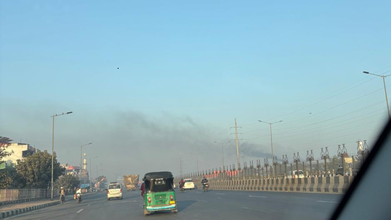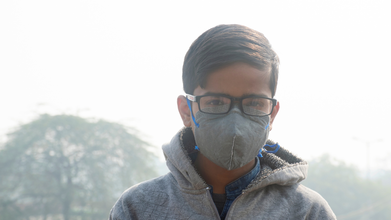- Health Conditions A-Z
- Health & Wellness
- Nutrition
- Fitness
- Health News
- Ayurveda
- Videos
- Medicine A-Z
- Parenting
Stressed At Work? Your Sleep Might Be Paying The Price, New Study Shows

Image Credit: Canva
How many nights have you spent lying in the dark, your mind churning over problems on the job, squabbles with coworkers, or critical career decisions? If the answer is more than a handful, you're part of a growing number of Americans who are having work-related stress steal their sleep, with potentially severe consequences for their health and productivity.
A new American Journal of Industrial Medicine report finally reveals that job-related stress is significantly responsible for sleep disturbances. According to senior researcher and UCLA professor of work and health Dr. Jian Li, this is an illustration of how desperate the situation is and how there is an imperative need for workplace interventions to support sleep health.
More than 1,700 US midlife workers were followed for up to nine years on average in this study. For sleep disturbances, researchers assessed symptoms of insomnia that included difficulty falling asleep, waking during the night, waking too early, and feeling unrested during the day.
The findings are striking: every method used to measure job strain showed a clear and significant link to higher rates of sleep disturbances. Dr. Li emphasizes that redesigning workloads and promoting worker autonomy are key strategies that could improve sleep health and overall well-being among employees.
About 1 in 7 adults in the U.S. report difficulty falling asleep, and 1 in 6 experience difficulty staying asleep," the scientists pointed out. These numbers characterize the more extensive public health challenge of insufficient sleep.
Why Does Stress Disrupt Sleep?
Stress interferes with sleep by extending the time required to fall asleep and causing constant awakenings throughout the night. According to the experts, most of this has to do with the overactive mind.
When people are stressed, their minds are usually running on responsibilities such as work, family, or money. For students and young adults, the source of stress usually revolves around exams or deadlines. These racing thoughts continue even when the body is trying to sleep, which creates a problem in sleep patterns.
Stress also activates the body's stress response system, leading to increased cortisol. This hormone heightens alertness but also causes further fragmentation of sleep, which creates a vicious cycle.
How Chronic Sleep Deprivation Affects the Human Body
Sleep deprivation is not just a nuisance; it has serious health consequences. Studies have shown that sleep deprivation can lead to the following:
- Impaired learning and memory
- Reduced metabolism
- Endocrine dysfunction
- Increased risk of accidents due to impairment during the day, especially when driving or operating machinery.
This would further point to the importance of dealing with root causes, of which workplace stress is one.
Also Read: Waking At 3 AM Every Night? It's Not A Ghost—It’s Your Body’s Warning Signal
Simple and Effective Tips for Better Sleep
Poor sleep is physically demanding. In fact, evidence indicates that small habits and environment modifications can be impactful if workplace stress impacts sleep. These are the suggestions of experts and researchers as part of evidence-based strategies:
1. Improve sleep hygiene
Good sleep hygiene is foundational to restful sleep. This includes:
- Avoiding caffeine in the evening.
- Reducing screen time before bed. Blue light from electronic devices disrupts melatonin production, making it harder to fall asleep. Use blue-light filter apps or settings if screen use is unavoidable.
- Creating a dark, quiet, and cool sleep environment.
2. Adopt Relaxation Techniques
Wind down after a busy day with calming activities such as yoga, warm baths, or guided meditation. Apps offering breathing exercises can also help quiet a racing mind. 3. Keep a Consistent Schedule
Consistency is key to regulating your internal clock. Aim to sleep and wake at the same time every day, including weekends.
4. Use Stimulus Control Therapy
If you wake up and find yourself lying awake, then try writing down your thoughts before bed. This will help declutter your mind and make it easier to relax.
5. Manage Responsibilities Strategically
Consider offloading some daytime tasks by using delivery services or delegating responsibilities. Carving out sufficient time for rest is essential for maintaining balance.
Should You Seek Professional Help for This?
While lifestyle adjustments can be effective, chronic sleep issues may require professional intervention. Insomnia can sometimes be a symptom of underlying conditions such as sleep apnea, mood disorders, or chronic pain. If your sleep problems lead to significant daytime impairment, consult a healthcare provider.
Experts advise against the use of over-the-counter products such as melatonin, as they may not treat the underlying cause of sleep disorders. A sleep specialist can offer a comprehensive assessment and treatment plan.
The study's authors point out that employers have a place in alleviating work-induced sleep disruptions. Other policies and programs devoted to reducing the job strain, like flexible schedules, workload management, and employee wellness initiatives, can also bring in huge benefits to both employees and the organization.
Workplace stress and sleep disturbances are closely linked, but they do not have to rule your nights-or your life. Healthier habits, support, and changes in the workplace can break the cycle of stress and sleeplessness. Your sleep is not just a personal matter; it is a cornerstone of your overall health and productivity. Taking steps to protect it is an investment in your future well-being.
Not Delhi, But Ghaziabad Ranks As The Most Polluted City In India; Doctors Warn Of Health Emergency

While Delhi again woke up to a thick layer of haze on Tuesday, December 9, with the AQI remaining in "poor" and "very poor" categories as per the Air Quality Early Warning System for Delhi. A new Centre for Research on Energy and Clean Air (CREA) report released on December 6 noted that it is not Delhi, but Ghaziabad, which is the most polluted city in India, as of November 2025.
What Makes Ghaziabad The Most Polluted City In India?
Ghaziabad remained most polluted city in India, with a monthly average of PM2.5 or particulate matter 2.5 at the concentration of 224 µg/m³. This means Ghaziabad violated the National Ambient Air Quality Standards (NAAQS) on every day of the month as per the CREA's Monthly Air Quality Snapshot.
Of the entire month, the city experienced 19 "very poor" days, with 10 "severe" days and 1 "poor" day. In the list of top 10, Noida, Bahadurgarh, Delhi, Hapur, Greater Noida, Baghpat, Sonipat, Meerut and Rohtak also joined the list.
Of the 10 cities, six of them were from Uttar Pradesh, followed by 3 cities from Haryana and then Delhi. All cities except Delhi recorded PM2.5 levels higher than the previous year.
What About The Pollution Levels In Delhi?
The national capital ranked as the fourth most polluted city, recording a monthly average PM2.5 concentration of 215 µg/m³ in November, about twice its October level of 107 µg/m³. The city experienced 23 ʻVery Poorʼ days, six ʻSevereʼ days, and one ʻPoorʼ day throughout November.
Despite widespread pollution, the contribution of stubble burning was comparatively lower this year, an average of seven per cent in November, down from 20 per cent last year. Peak contributions of stubble burning reached 22 per cent, significantly lower than 38 per cent recorded in the previous year.
The analysis drew on real-time continuous ambient air quality monitoring stations (CAAQMS) PM2.5 data.
“Despite a significant reduction in stubble-burning influence, 20 out of 29 NCR cities recorded higher pollution levels than the previous year, and many still did not register a single day within NAAQS limits. This clearly indicates that the dominant drivers are year-round sources such as transport, industry, power plants, and other combustion sources. Without sector-specific emission cuts, cities will continue to breach standards,” said Manoj Kumar, analyst at CREA.
CREA's previous report has highlighted that Delhi’s air pollution almost doubled in November, with average PM2.5 levels touching 215 micrograms per cubic meter. The city recorded 23 days of very poor air, six severe days, and only one poor day. Although stubble burning played a smaller role this year, contributing an average of 7 percent, the pollution remained dangerously high.
Across India, pollution trends were equally worrying. Nine of the ten most polluted cities saw higher pollution levels than last year. Ghaziabad was the worst affected, with PM2.5 levels at 224 micrograms per cubic meter.
According to CREA analyst Manoj Kumar, declining stubble burning shows some progress, but major year round sources such as transport, industry, power plants, and other combustion activities continue to drive the crisis. Without strong emission cuts in these sectors, pollution levels will keep breaching national standards.
Doctors Warn of a Deepening Health Emergency
In an interview with ANI, doctors from AIIMS described Delhi’s air quality as a medical emergency. Prof Dr Anant Mohan and Dr Saurabh Mittal from the Department of Pulmonary, Critical Care, and Sleep Medicine said the current situation is now putting vulnerable groups at serious risk, including pregnant women, unborn babies, newborns, and adults with heart or neurological conditions.
Dr Mohan warned that the impacts may be felt for generations. Since the particles are extremely small, they can pass from a pregnant woman to the fetus and interfere with growth. Babies exposed to such conditions in the womb are more likely to be underweight and may have weaker lungs as they grow. Some complications might show up only later in life.
Dr Mittal added that the effects of toxic air go far beyond respiratory illness. Prolonged exposure is increasing cases of breathlessness, lung inflammation, asthma attacks, and chronic conditions like COPD. Fine particulate matter is also entering the bloodstream, raising the risk of heart attacks and strokes.
The growing health concerns underline the need for immediate and coordinated action, making the work of the newly formed expert group even more urgent.
How To Read Delhi's AQI?
- 0-50: 'good'
- 51-100: 'satisfactory'
- 101-200: 'moderate'
- 201-300: 'poor'
- 301-400: 'very poor'
- 401-500: 'severe'
New Mpox Strain Detected In England; It Is A Mix Of Clade Ib and Clade IIb, More Details Inside

Credits: iStock
A new strain of mpox or what was previous known as monkeypox has been detected in a person in England, confirmed the UK health officials. This strain is a mix of the two major type of mpox virus that was found in someone who had recently returned from travelling in Asia.
The officials have said that they are still assessing the significance of the new strain. As per the UK Health Security Agency (UKHSA), it is normal for viruses to evolve. The best shield of protection is to get vaccinated against such disease, even if the infector remain mild for most.
What Is The New Virus Strain Of Mpox?
The new virus strain contains elements from two mpox strain, which are clade Ib and clade IIb. The strain as of now has no name.
UK officials have also recently encouraged gay, bisexual and other men who have sex with men to get vaccinated against mpox. This call has come as the strain clade Ib showed early signs of local spread in some of the European countries. Whereas, the clade IIB is linked to a global outbreak of mpox in 2022 that affected countries across the globe.
Vaccines Available For Who?
In the UK, the vaccination is available for the most vulnerable group at the risk of catching mpox:
- those who have multiple sexual partners
- those who engage in group sex
- those who visit sex-on-premises venues
Health officials report that the mpox vaccine offers about 75 to 80 percent protection. Although there are no specific studies yet on how well the vaccine works against the newest strain, experts believe it should still provide a strong level of defense.
Dr. Katy Sinka, head of sexually transmitted infections at the UK Health Security Agency (UKHSA), told BBC that genomic testing made it possible to identify this strain. She explained that viruses naturally evolve and that ongoing analysis will help scientists understand how mpox is changing. Dr. Sinka encouraged eligible individuals to get vaccinated, calling it a proven way to prevent severe illness.
Global Readiness and Gaps in Access
Prof. Trudie Lang, director of the Global Health Network at the University of Oxford, told the BBC that the UK has strong systems to detect cases and stop further spread. However, she noted that this is much more difficult in other regions, particularly in vulnerable populations where vaccine access is limited.
According to Prof. Lang, if more cases of this strain begin to appear in the UK or internationally, researchers will need to closely track how the virus spreads and how sick it makes people. Understanding these patterns will help determine whether the new strain poses more or less risk than previous ones.
Rising Global Cases and Concerns
Nearly 48,000 mpox cases have been confirmed worldwide in 2025, including about 2,500 in the past month. Most infections have been reported in central Africa.
Dr. Boghuma Titanji, assistant professor of medicine at Emory University, said the emergence of a new strain is what experts expected as the virus continued to circulate globally. She warned that allowing ongoing transmission gives mpox more chances to adapt and embed itself as a long-term human pathogen.
What Is Mpox?
Mpox is a viral illness that can cause significant discomfort. Common symptoms include lesions or a rash lasting two to four weeks. People may also experience fever, headaches, back pain, muscle aches and fatigue.
The virus spreads through close physical contact, respiratory droplets from coughs or sneezes and shared items such as bedding, towels or clothing.
Health officials advise anyone who suspects they may have mpox to contact NHS 111 for guidance on next steps.
Health Emergency Looms As Delhi Forms Expert Panel To Fight Air Pollution

Credits: iStock
Coughs. Sneezing. Wheezing. All of this can be heard everywhere, with many people taking sick leaves, and coming back to office still with health complains. This is what is happening in Delhi as the national capital remains in the 'very poor' category for its Monday morning Air Quality Index (AQI). The average AQI of the city stood at 318 on 7am, as per the Central Pollution Control Board (CPCB). The thick layer of smog has engulfed the city and there has been no improvement to get rid of the toxic air. Visibility too has been reduced in several areas, including Anand Vihar, India Gate, Dwarka, and ITO.
Amid the continuously worsening air condition in Delhi, the government has now formed an 'expert group' to combat air pollution as health crisis rise.
The panel will study how pollution builds up from human activity as well as natural causes and will recommend technology upgrades, policy reforms, and sector specific interventions that can be put into action.
Who Will Lead the Expert Panel
The group will be chaired by retired IAS officer and former Union Environment Secretary Leena Nandan. Other members include former CPCB member secretary Dr JS Kamyotra, IIT Delhi professor emeritus Mukesh Khare, IIT Kanpur professor emeritus Mukesh Sharma, and Dr Suneel Pandey, director of Circular Economy and Waste Management at TERI. Representatives from CAQM, the IMD, APAG, PHDCCI and senior officials from the Delhi government are also part of the group. The Secretary of Environment and Forest is a member, and the DPCC chairman will serve as member secretary.
What the Group Will Do
This expert panel will act as a high level advisory body, offering clear, actionable guidance that can shape both emergency responses and long term reforms. It will track the progress of current pollution control programs, study global best practices, and flag where corrections are needed. The group will meet every month, either in person or virtually, and will receive administrative support from the Delhi Pollution Control Committee. The initial tenure is six months, with the option to extend if required.
Government Planning and Oversight
Chief Minister Rekha Gupta has approved the expert group, along with a separate High Level Implementation Committee chaired by the Chief Secretary. While the expert group will guide policy and strategy, the implementation committee is responsible for enforcing directives, coordinating across departments, and ensuring timely action. Delhi BJP leader Manjinder Singh Sirsa has welcomed the move and said that combined efforts from the government and citizens can make a meaningful difference.
Delhi’s Pollution Levels Are Rising Fast
A new analysis by the Centre for Research on Energy and Clean Air (CREA) highlights the scale of the crisis. Delhi’s air pollution almost doubled in November, with average PM2.5 levels touching 215 micrograms per cubic meter. The city recorded 23 days of very poor air, six severe days, and only one poor day. Although stubble burning played a smaller role this year, contributing an average of 7 percent, the pollution remained dangerously high.
Across India, pollution trends were equally worrying. Nine of the ten most polluted cities saw higher pollution levels than last year. Ghaziabad was the worst affected, with PM2.5 levels at 224 micrograms per cubic meter.
According to CREA analyst Manoj Kumar, declining stubble burning shows some progress, but major year round sources such as transport, industry, power plants, and other combustion activities continue to drive the crisis. Without strong emission cuts in these sectors, pollution levels will keep breaching national standards.
Doctors Warn of a Deepening Health Emergency
In an interview with ANI, doctors from AIIMS described Delhi’s air quality as a medical emergency. Prof Dr Anant Mohan and Dr Saurabh Mittal from the Department of Pulmonary, Critical Care, and Sleep Medicine said the current situation is now putting vulnerable groups at serious risk, including pregnant women, unborn babies, newborns, and adults with heart or neurological conditions.
Dr Mohan warned that the impacts may be felt for generations. Since the particles are extremely small, they can pass from a pregnant woman to the fetus and interfere with growth. Babies exposed to such conditions in the womb are more likely to be underweight and may have weaker lungs as they grow. Some complications might show up only later in life.
Dr Mittal added that the effects of toxic air go far beyond respiratory illness. Prolonged exposure is increasing cases of breathlessness, lung inflammation, asthma attacks, and chronic conditions like COPD. Fine particulate matter is also entering the bloodstream, raising the risk of heart attacks and strokes.
The growing health concerns underline the need for immediate and coordinated action, making the work of the newly formed expert group even more urgent.
How To Read Delhi's AQI?
0-50: 'good'
51-100: 'satisfactory'
101-200: 'moderate'
201-300: 'poor'
301-400: 'very poor'
401-500: 'severe'
© 2024 Bennett, Coleman & Company Limited

